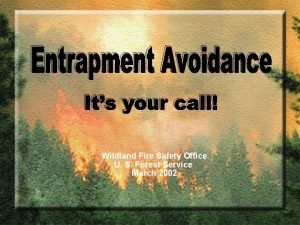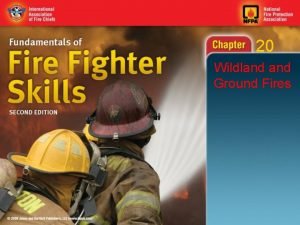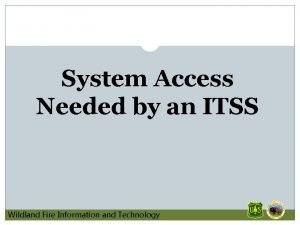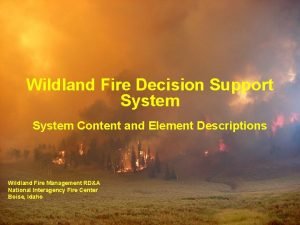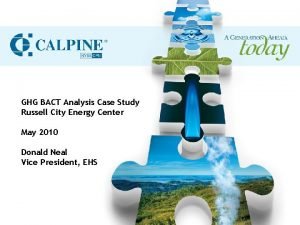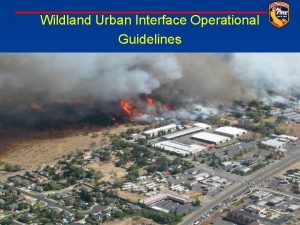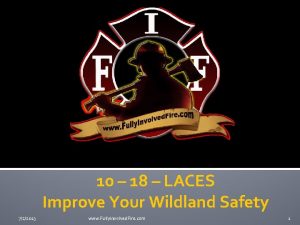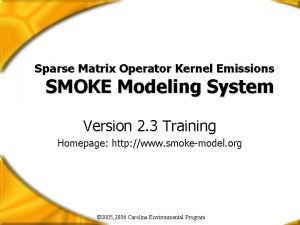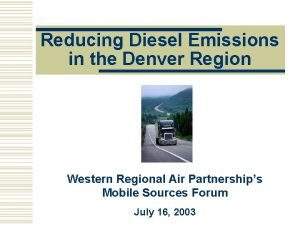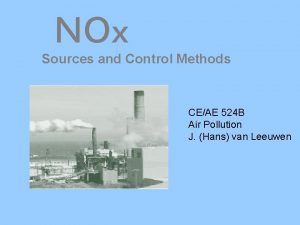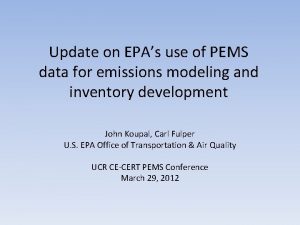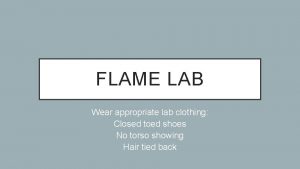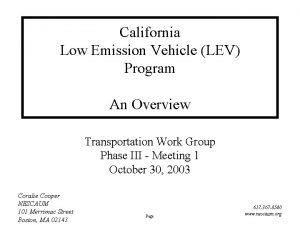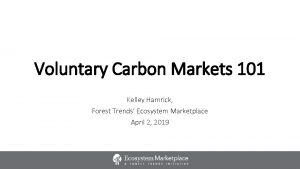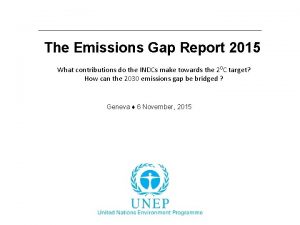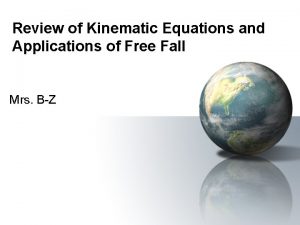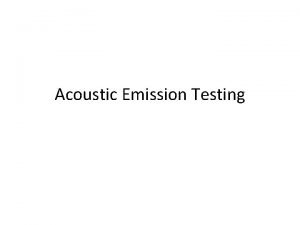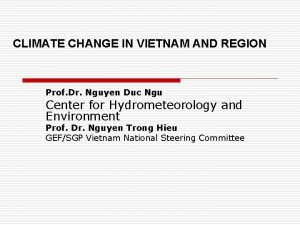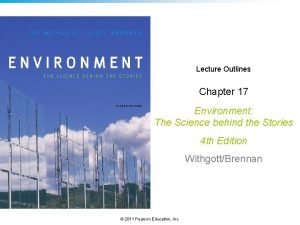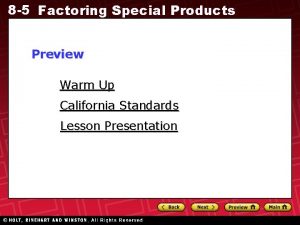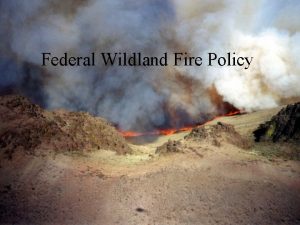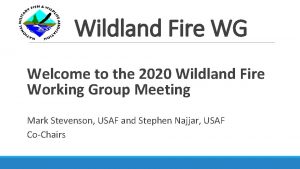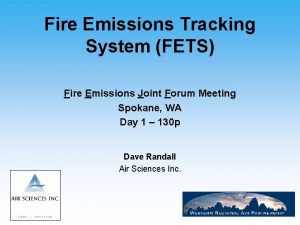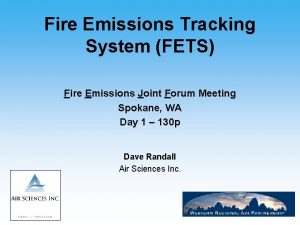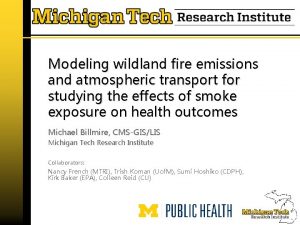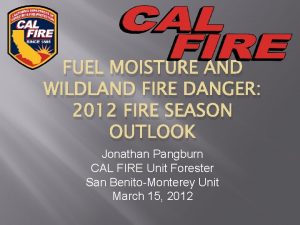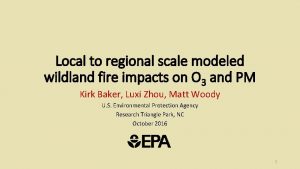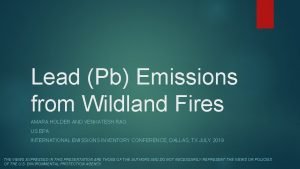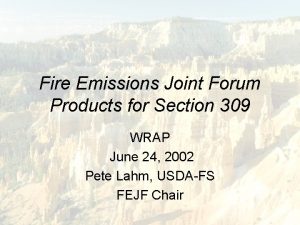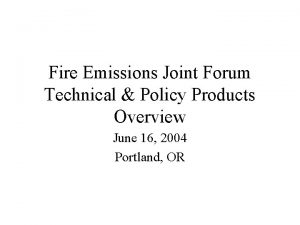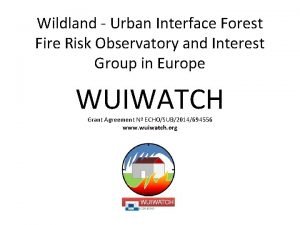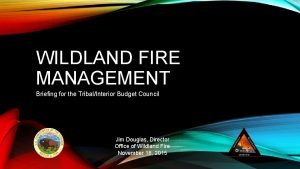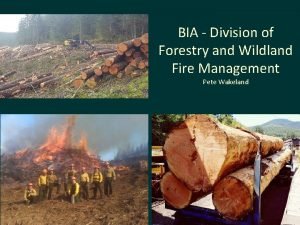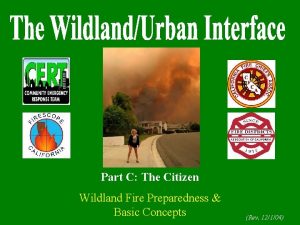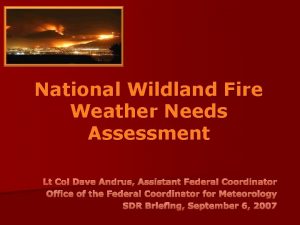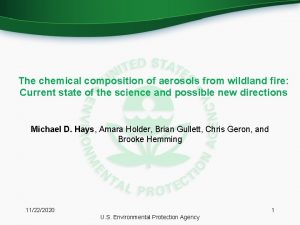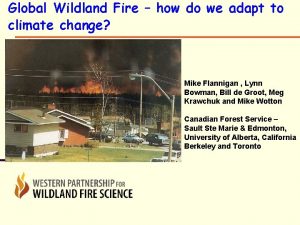Regional Fire Emissions Products using the Wildland Fire



































- Slides: 35

Regional Fire Emissions Products using the Wildland Fire Emissions Information System A 2012 NASA-CMS Phase 2 study Lead Investigators: Nancy HF French, MTRI Don Mc. Kenzie, US Forest Service, PNW, FERA Eric Kasischke, University of Maryland Presented by: Michael Billmire, MTRI (WFEIS technical lead) www. mtri. org

wfeis. mtri. org


Modeling Wildland Fire Emissions Fuel moisture

Modeling Wildland Fire Emissions: WFEIS Fuel moisture Burned area products provide: burn area location -> tells us fuel loadings, fuel moisture day -> tells us fuel moisture Options: MODIS MCD 64 A 1 MTBS burn perimeters Daily progression (MODIS Active Fire interpolated to MTBS) Smart. Fire 2011 NEI Agricultural NEI (Mc. Carty)

Modeling Wildland Fire Emissions: WFEIS Fuel moisture Fuel type (from 1 -km FCCS map) linked to stratified fuel loadings (biomass)

Modeling Wildland Fire Emissions: WFEIS Fuel moisture Daily gridded weather Daily fuel moisture interpolated from RAWS data from 1986 through 2013 at 40 -km scale for all of CONUS

Modeling Wildland Fire Emissions: WFEIS Fuel moisture Consumption & Emissions model (CONSUME)

Modeling Wildland Fire Emissions: WFEIS Fuel moisture

Main Project Objectives Improve WFEIS • Improve inputs: fuel loading (biomass), fuel moisture • Develop methodology for uncertainty measurement for emissions estimations Produce regional emissions estimates Compare these estimates to CASA GFED estimates

Objective Improve WFEIS inputs

Refining the fuels map for CONUS (Co-I Mc. Kenzie) aggregated classes Each instance of a class (cell) is assigned a unique set of fuel loadings. Biomass varies across instances of each class

Refining the fuels map for CONUS (Co-I Mc. Kenzie) We can use remote sensing products to help to more appropriately characterize canopy fuels and thus provide fuel load variation within a single fuel type Tree cover Non-tree cover Bare ground continuous values

Refining the fuels map for CONUS (Co-I Mc. Kenzie) Result: The new 1 -km MODIS-enhanced FCCS Canopy fuel loadings in forested fuelbeds are generally lower. Exceptions in northern Rocky Mts, Northeast, Gulf coast, upper Michigan. As expected, spatial variation is more “realistic” in MODISenhanced fuel layer. 14

Task: Improved Fuel Moisture Inputs Before: -by Level II CEC Ecoregion Now: -by 40 km grid cell (interpolated from RAWS) “Improved” = • better spatial resolution • updated through 2013 15

Develop methodology for assessing uncertainty Achievements: – Developed a framework for estimating the various components of WFEIS model uncertainty – Mathematically rigorous documentation of the (~60) Consume regression equations – Identified all possible sources of error: • Coefficient error for each regression-based prediction equation • Input measurement error (e. g. measurements from field work) • Classification error (e. g. accuracy of spatial data)

Provide Assessment of Uncertainty in Emissions Estimates Achievements: – Conducted case studies on two of Consume’s regression-based consumption equations – The two studies were done for the shrub and for the western woody fuel strata – These examples demonstrated both sample-based and Monte Carlo approaches to uncertainty and sensitivity analysis.

Objective Produce regional emissions estimates

WFEIS Emissions Estimates

WFEIS Emissions Estimates All available at: http: //wfeis. mtri. org/media/model_outputs


Region 11 – Mediterranean California This is the only ecoregion in the continental US with a Mediterranean climate – summers are hot and dry, and winters are mild. Droughts are common, with precipitation averaging from 200 -1, 000 mm per year. With irrigation, these features create a prime environment for high value agriculture. Native vegetation is dominated by shrubs, with patchy areas of grasslands and forests of evergreen and deciduous trees. 11. 1 Mediterranean California

Objective Compare to CASA GFED estimates

GFED comparison to WFEIS (with collaborator Collatz) Comparison between GFEDv 3 (published emissions) and WFEISv 0. 3 for TENA/CONUS 2001 -2010 GFEDv 3 is the fire emissions module in CASA-GFED, one of the models used in the CMS-Flux pilot for terrestrial C flux estimates

GFED comparison to WFEIS (with collaborator Collatz) Summary of differences between major model components

GFED comparison to WFEIS (with collaborator Collatz) Modeled emission results comparison – Carbon: GFED ~50% of WFEIS

GFED comparison to WFEIS (with collaborator Collatz) Modeled emission results comparison – CO 2: GFED ~95% of WFEIS

The Road Ahead Project is complete, BUT we are currently seeking funding for the continued development/maintenance of WFEIS and are eager to get to work on the following important tasks: – Full uncertainty characterization of the CONSUME model • Started under this project; statistical framework established and demonstrated test cases for several of the ~60 consumption equations • Once complete, the end goal is for WFEIS outputs (and any other modeling effort making use of the CONSUME model) to deliver uncertainty estimates

The Road Ahead Project is complete, BUT we are currently seeking funding for the continued development/maintenance of WFEIS and would love to get to work on the following important tasks: • Integrate information on land disturbance from remote sensing and other geospatial products to update dynamically the representation of fuel loadings in WFEIS

The Road Ahead Project is complete, BUT we are currently seeking funding for the continued development/maintenance of WFEIS and would love to get to work on the following important tasks: • Develop international versions of WFEIS

Project Team Michigan Tech Research Institute Nancy HF French, PI Michael Billmire, Arthur Endsley, Nicholas Molen, Jessica Mc. Carty, Reid Sawtell, Amanda Grimm, Amy Howes, Kim Mobley USFS Fire and Environmental Research and Applications and University of Washington Don Mc. Kenzie, Co-I Roger Ottmar, Susan Prichard, Rob Norheim Eric S Kasischke, Co-I, UMd Jim Collatz, Collaborator, GSFC

GFED comparison to WFEIS (with collaborator Collatz) Burned area comparison – GFED 2% higher than WFEIS

GFED comparison to WFEIS (with collaborator Collatz) Fuel available comparison – GFED 55% lower than WFEIS

GFED comparison to WFEIS (with collaborator Collatz) Combustion completeness comparison – GFED 15% higher than WFEIS

GFED comparison to WFEIS (with collaborator Collatz) Emission factors comparison – Carbon: GFED 5% lower than WFEIS – CO 2: GFED 80% higher than WFEIS
 Trigger points wildland fire
Trigger points wildland fire Pincer attack wildland fire
Pincer attack wildland fire Itss nwcg
Itss nwcg Wfdss
Wfdss Using citys heat reduce emissions
Using citys heat reduce emissions Firescope structure triage
Firescope structure triage Laces wildland
Laces wildland Nspe code of ethics quiz
Nspe code of ethics quiz Sparse matrix operator kernel emissions
Sparse matrix operator kernel emissions Diesel emissions denver
Diesel emissions denver Sources of nox emissions
Sources of nox emissions Parts of sperm cell
Parts of sperm cell Pems emissions modeling
Pems emissions modeling Where else have you observed colorful light emissions
Where else have you observed colorful light emissions Lev 2 emissions
Lev 2 emissions Un emissions gap report
Un emissions gap report Un emissions gap report
Un emissions gap report Kinematic equations examples
Kinematic equations examples Acoustic emission testing applications
Acoustic emission testing applications Ghs emissions
Ghs emissions Splonc
Splonc Functional vs innovative supply chain
Functional vs innovative supply chain Marketing mix of pepsi and coca cola
Marketing mix of pepsi and coca cola Multiply decimals using partial products
Multiply decimals using partial products Using special products part 2
Using special products part 2 Hình ảnh bộ gõ cơ thể búng tay
Hình ảnh bộ gõ cơ thể búng tay Lp html
Lp html Bổ thể
Bổ thể Tỉ lệ cơ thể trẻ em
Tỉ lệ cơ thể trẻ em Voi kéo gỗ như thế nào
Voi kéo gỗ như thế nào Tư thế worm breton là gì
Tư thế worm breton là gì Chúa yêu trần thế
Chúa yêu trần thế Môn thể thao bắt đầu bằng chữ f
Môn thể thao bắt đầu bằng chữ f Thế nào là hệ số cao nhất
Thế nào là hệ số cao nhất Các châu lục và đại dương trên thế giới
Các châu lục và đại dương trên thế giới Công thức tiính động năng
Công thức tiính động năng
